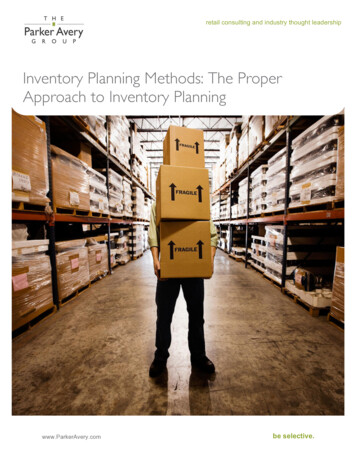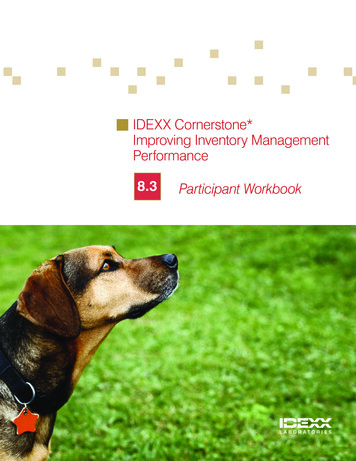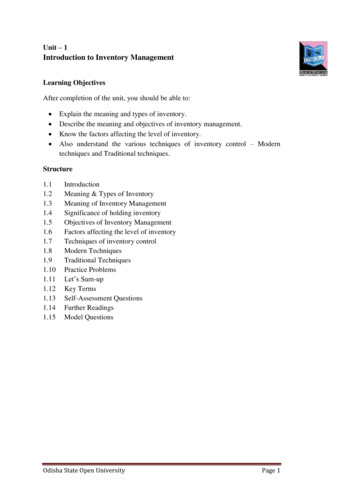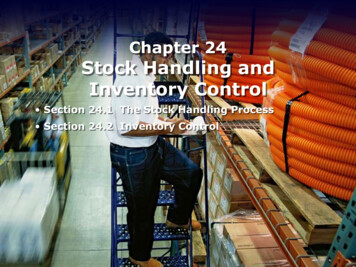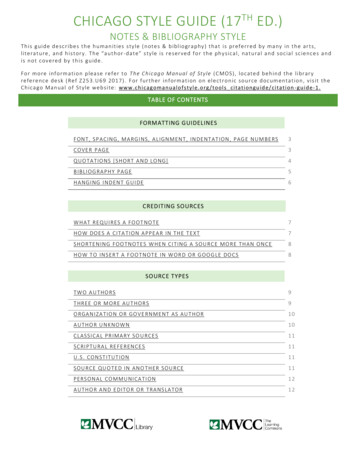
Transcription
PERSONAL STYLE INVENTORY R. Craig Hogan and David W. ChampagneJust as every person has differently-shaped feet and toes from every other person, so we all havedifferently "shaped" personalities. Just as no person's foot shape is "right" or "wrong," so noperson's personality shape is right or wrong. The purpose of this inventory is to give you a pictureof the shape of your preferences, but that shape, while different from the shapes of other persons'personalities, has nothing to do with mental health or mental problems.The following items are arranged in pairs (a and b), and each member of the pair represents apreference you may or may not hold. Rate your preference for each item by giving it a score of 0 to5 (0 meaning you really feel negative about it or strongly about the other member of the pair, 5meaning you strongly prefer it or do not prefer the other member of the pair). The scores for a andb MUST ADD UP TO 5 (0 and 5, land 4, 2 and 3, etc.). Do not use fractions such as 2%.I prefer:1a. making decisions after finding out what others think.1b. making decisions without consulting others.2a. being called imaginative or intuitive.2b. being called factual and accurate.3a. making decisions about people in organizations based on available data and systematicanalysis of situations.3b. making decisions about people in organizations based on empathy, feelings,and understanding of their needs and values.4a. allowing commitments to occur if others want to make them.4b. pushing for definite commitments to ensure that they are made.5а. quiet, thoughtful time alone.5b. active, energetic time with people.6a. using methods I know well that are effective to get the job done.6b. trying to think of new methods of doing tasks when confronted with them.7а. drawing conclusions based on unemotional logic and careful step-by-step analysis.7b. drawing conclusions based on what I feel and believe about life and peoplefrom past experiences.Copyright 1979 by D. W. Champagne and R. C. Hogan. Reprinted with permission of the authors fromthe privately published book Supervisory and Management Skills: A Competency Based Training Programfor Middle Manager of Educational Systems by D. W. Champagne and R. C. Hogan. This material may befreely reproduced for educational training/ research activities. There is no requirement to obtain specialpermission for such uses. However, systematic or large-scale reproduction or distribution- or inclusion ofitems in publications for sale - may he done only with prior written permission of the authors,928a. avoiding making deadlines.University Associates
8b. setting a schedule and sticking to it.9a talking a while and then thinking to myself about the subject.9b. talking freely for an extended period and thinking to myself at a later time.10a. thinking about possibilities.10b. dealing with actualities.11a. being thought of as a thinking person.11b. being thought of as a feeling person.12a. considering every possible angle for a long time before and after making a decision.12b. getting the information I need, considering it for a while, and then making afairly quick, firm decision.13a. inner thoughts and feelings others cannot see.13b. activities and occurrences in which others join.14a. the abstract or theoretical.14b. the concrete or real.15a. helping others explore their feelings.15b. helping others make logical decisions.16a. change and keeping options open.16b. predictability and knowing in advance.17a. communicating little of my inner thinking and feelings.17b. communicating freely my inner thinking and feelings.18a. possible views of the whole.18b. the factual details available.19a. using common sense and conviction to make decisions.19b. using data, analysis, and reason to make decisions.20a. planning ahead based on projections.20b. planning as necessities arise, just before carrying out the plans.21a. meeting new people.21b. being alone or with one person I know well.22a. ideas.22b. facts.The 1980 Annual Handbook for Group Facilitators23a. convictions.23b. verifiable conclusions.24a. keeping appointments and notes about commitments in notebooks or inappointment books as much as possible.93
24b. using appointment books and notebooks as minimally as possible (althoughI may use them).25a. discussing a new, unconsidered issue at length in a group.25b. puzzling out issues in my mind, then sharing the results with anotherperson.26a. carrying out carefully laid. detailed plans with precision.26b. designing plans and structures without necessarily carrying them out.27a. logical people.27b. feeling people.28a. being free to do things on the spur of the moment.28b. knowing well in advance what I am expected to do.29a. being the center of attention.29b. being reserved.30a. imagining the nonexistent.30b. examining details of the actual.3la. experiencing emotional situations, discussions, movies. 3 lb. using my ability to analyzesituations.32a. starting meetings at a prearranged time.32b. starting meetings when all are comfortable or ready.94University Associates
PERSONAL STYLE INVENTORY SCORING SHEETInstructions: Transfer your scores for each item of each pair to the appropriateblanks. Be careful to check the a and b letters to be sure you are recording scoresin the right blank spaces. Then total the scores for each .29b.29a.30a.30b.Total NTotal STotal ITotal a.32b.32a.Total TTotal FThe 1980 Annual Handbook for Group FacilitatorsDEFINITIONS - THE FOUR PAIRS OF PREFERENCESTotal PJTotal J95
E ( EXTRAVERSION) or I ( INTROVERSION):Preference for how personal energy is replenished:Strong "E" score - gets energized and replenished by interactionwith lots of peopleStrong "I" score - gets energized and replenished by doing thingsalone,or with chosen, trusted friend or intimateS (SENSATION) or N (INTUITION)Preference for how information is validated:Strong "S" score - trusts information which comes from physical,sensory sources and own or other people's, experiences - the actualStrong "N" score - trusts information which intuitively feelsright; is more oriented to the "possible" than the "past"T (THINKING) or F (FEELING)Preference for how to base choices and decisions:Strong "T" score - prefers to make decisions based on a logicalthought process, established principles, objective external criteriaStrong "F" score - prefers to make decisions based on own orothers' feelings or the potential impact of a decision on peopleP (PERCEIVING) or J (JUDGING)Preference for how long to keep options open or how quickly to "get to the bottomline":Strong "P" score - prefers to weigh options and keep decisions openStrong "J" score - prefers to get closure, make decision8/86
PERSONAL STYLE INVENTORY R. Craig Hogan and David W. Champagne Just as every person has differently-shaped feet and toes from every other person, so we all have differently "shaped" personalities. Just as no person's foot shape is "right" or "wrong," so no person's personality shape is right or wrong.File Size: 202KB





